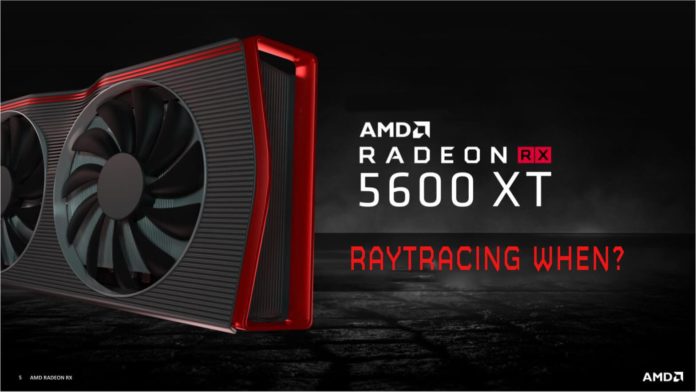Ever since AMD announced their Navi RDNA-based GPUs last year, the one main question that everyone has had on their mind is – When is AMD raytracing arriving? We saw NVIDIA implement the much talked about feature in their Turing architecture back in 2018, but team red has been silent about it. Of course, with the Radeon RX 5000 series, AMD has caught up to NVIDIA in terms of raw power (more or less) in almost every price segment. But if there’s one thing that they’re still missing – it’s that shiny raytracing implementation that the Geforce RTX cards come with.
Well, in a recent press briefing the same question was posed to team red and here’s what they said:
AMD as a company…strongly believes in the value and capability of raytracing. RDNA 2, the next-gen, will support raytracing. Both the next-gen Xbox and PlayStation will support hardware raytracing with Radeon natively. We will be sure to have the content that gamers can actually use to run on those GPUs
We believe in our raytracing, and we will have it when the time is right.
Mithun Chandrashekhar, Product Management Lead, AMD

It’s been well documented that both the next-gen consoles are using AMD raytracing hardware, and AMD CEO Lisa Su has herself addressed the lack of the same on current consumer GPUs. The company is now saying that they want to wait for more games to adopt raytracing before they launch consumer segment cards to tackle it. The company sounded very confident in its implementation of the technology in its upcoming cards.
While there’s still time for AMD’s raytracing, they’ve been working hard on providing more GPUs at different price points. The upcoming RX 5600 XT is poised to take the mantle of the GTX 1060 as a long-running 1080p champion. Of course, while benchmarks are one thing, we still have to see test the cards in real-world scenarios. We’ll keep you updated on more gaming hardware news.
Further Reading:



With the PS5’s probable release in November and the new Xbox Scarlet around the same time. RTRT Games developed for those platforms will port to PC’s with RDNA2 graphics cards. I would think those console manufacturers would have stitched up an exclusivity period and so would expect RDNA2 to surface next year. With RDNA release on July 7th 2019, a one yearly cadence would put release of RDNA2 mid this year except the complete line up of original Navi isn’t out yet. Big Navi rumors are starting to heat up. Navi 12 or Navi 21? GCN5 to RDNA was two years apart. But GCN4 to 5 was yearly, but then Vega was the big card and Polaris was the small so really two years for a complete cycle of the product stack. Cadence seems to speed up through the life cycle of an architechture.
Navi 12 would have entered the development cycle ahead of Navi 14 yet hasn’t emerged as a product yet. It has either been killed off in favor of something different or is waiting for something such as the process to mature and yields to improve or maybe even for the next more refined process to increase transistor density and reduce power consumption. TSMC had yield of just 32% in 100 mm^2 size on 5nm process at the end of last year. Big Navi die would likely need to be much larger than this even on N5. Navi 10 is 251 mm^2. If big Navi is as rumored, and basically two times Navi 10, then it would be about 500 mm^2 on N7FF but closer to 280 mm^2 on N5. Yields would be very poor at that size on N5 at the moment. Size would be around 425 mm^2 on N7FF+. This is much more likely until N5 is much more mature. Nvidia had to devote a considerable amount of die area to Hardware accelerated ray tracing and AI so inclusion of such would alter the picture again. N7FF+ uses EUV steps in process and so is likely to be a more expensive process.
It is starting to sound like Navi 12 has been killed off in favor of an RDNA2 version on N7FF+. With the consoles set for release at the end of this year the Real Time Ray Tracing market should reach critical mass around this time or shortly after with AMD’s version at its epicenter. It makes sense if AMD needed the new node for density and efficiency, to make Big Navi work, that it develops RDNA2 on that node for development capital efficiency reasons. The power requirements of a large GPU dictate it be produced on a leading-edge node (currently N7+). Closeness of expected market expansion pushes Big Navi to be RDNA2. The detractor for this is the die size would be big, assuming AMD hasn’t cracked the multi chiplet GPU problem yet and GPU’s must still be monolithic. I imagine AMD would want a mass market RTRT GPU around this time also. Porting a successful release to lower level GPU’s would be developmentally efficient. Porting an N7 part to N7+ is a significant undertaking where as N7 to N6 is simpler. N7+ has been in high volume production since October 2019 with yields as good as N7. N7+ Products should be in customer hands early this year (AMD stuff?). N6 currently seems to have little advantage over N7+ besides an easy transition and would be too late for this.